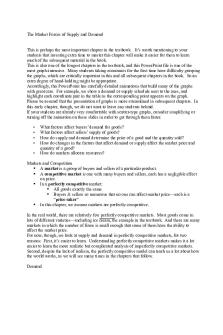Microeconomics chapter 1 notes PDF

| Title | Microeconomics chapter 1 notes |
|---|---|
| Author | ML SL |
| Course | Introduction to Microeconomics |
| Institution | University of Ottawa |
| Pages | 3 |
| File Size | 122.1 KB |
| File Type | |
| Total Downloads | 84 |
| Total Views | 136 |
Summary
Download Microeconomics chapter 1 notes PDF
Description
Microeconomics chapter key terms, resources, & class notes
Chapter 1 Economics: the study of how people, individually and collectively, manage resources Microeconomics: the study of how individuals and firms manage resources Macroeconomics: the study of economy on a regional, national, or international scale Scarcity: the condition of wanting more than we can get with available resources
Important performance measurements -
Gross Domestic Product (GDP) ➔ measurement of national income Unemployment Rates Consumer Price Index (CPI)
Opportunity cost: the value of what you have to give up in order to get something; the value of your next-best alternative. i.e. The opportunity cost of taking a vacation instead of spending the money on a new car is not getting a new car (https://www.youtube.com/watch?v=x-hYzRncxTc&ab_channel=MarginalRevolution University)
Marginal decision making: comparison of additional benefits of a choice against the additional cost it would bring, without considering related benefits and costs of past choices (the idea that rational people compare the additional benefuts of a choice against the additional costs, without considering related benefits and costs of past choices). A few examples in video (https://www.youtube.com/watch?v=-EEl5AIq4sY&ab_channel=PersonalFinanceinth eElementaryGrades) Sunk cost: costs that have already been incurred and cannot be recovered or refunded Incentives: something that causes people to behave in a certain way by changing the trade-offs they face Positive statement: a statement that makes a factual declaration about how the world actually works Normative statement: a statement that makes a claim about how the world should be
Class #1 Economic resources Resources: tangible and intangible things: cash, land, time, ideas, technology, experience, relationship
↪ Land: natural resources or any derivative thereof crops, minerals, land itself (on which buildings and structures lie)
↪ Labour: human effort ↪ Capital: something that is used to make something else i.e. structures, vehicles, plant & equipment, machinery It is not altered or consumed in the production process, but it does depreciate. Even though there are illimited wants for these resources, they’re only available in limited quantities, because we have limited means to produce. The Market Economy The two main economic actors are consumers and producers who interact to create the market.
Market economy: an economy in which private individuals, rather than a centralized planning authority, make the decisions 3 coordination tasks of any economy 1. What goods and services should be produced, and in what quantities? 2. How should they be produced? In other words, what is the technology? 3. For whom are the goods and services produced? Key features of a market economy ➔ The decentralized fashion in which consumption, production, and exchange decisions are made. ➔ It is extremely inegalitarian ➔ It is efficient in that shortages and surpluses are eliminated, and production of goods and services is in line with society’s needs and wants and is maximized in the face of scarcity ➔ It is dynamic as it adjusts rapidly to changes in technology, consumer tastes, demography The command Economy Command economy: an economy in which production, investment, prices, and incomes are determined centrally by a government.
↪ It executes the three essential tasks in a centralized fashion. All allocative decisions made at headquarters. Robinson Crusoe: simplest economy with one producer and consumer.
Tribal economy: an economy where all members are assigned producer roles and get a share of the consumer roles.
Mixed economy : an economy where elements of both market and command economies. Often countries that appear purely market still have large public government run public sectors....
Similar Free PDFs

Microeconomics chapter 1 notes
- 3 Pages

Microeconomics Quiz 1 Notes
- 4 Pages

Microeconomics chapter 1
- 3 Pages

Microeconomics - 1 full notes
- 46 Pages

Microeconomics Unit 1 notes
- 11 Pages

Microeconomics notes
- 64 Pages

Microeconomics - Lecture notes 1-12
- 34 Pages

Microeconomics 1
- 2 Pages

Microeconomics Quiz 3 Notes
- 4 Pages
Popular Institutions
- Tinajero National High School - Annex
- Politeknik Caltex Riau
- Yokohama City University
- SGT University
- University of Al-Qadisiyah
- Divine Word College of Vigan
- Techniek College Rotterdam
- Universidade de Santiago
- Universiti Teknologi MARA Cawangan Johor Kampus Pasir Gudang
- Poltekkes Kemenkes Yogyakarta
- Baguio City National High School
- Colegio san marcos
- preparatoria uno
- Centro de Bachillerato Tecnológico Industrial y de Servicios No. 107
- Dalian Maritime University
- Quang Trung Secondary School
- Colegio Tecnológico en Informática
- Corporación Regional de Educación Superior
- Grupo CEDVA
- Dar Al Uloom University
- Centro de Estudios Preuniversitarios de la Universidad Nacional de Ingeniería
- 上智大学
- Aakash International School, Nuna Majara
- San Felipe Neri Catholic School
- Kang Chiao International School - New Taipei City
- Misamis Occidental National High School
- Institución Educativa Escuela Normal Juan Ladrilleros
- Kolehiyo ng Pantukan
- Batanes State College
- Instituto Continental
- Sekolah Menengah Kejuruan Kesehatan Kaltara (Tarakan)
- Colegio de La Inmaculada Concepcion - Cebu






